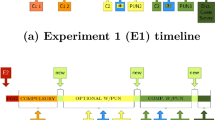Abstract
Using a laboratory experiment, we examine whether voluntary sanctions induce subjects to coordinate more efficiently in a repeated minimum-effort game. While most groups first experience Pareto inferior coordination in a baseline treatment, the level of effort increases substantially once ex post sanctioning opportunities are introduced, that is, when one can assign costly punishment points to other group members to reduce their payoffs. We compare the effect of this voluntary punishment possibility with the effect of ex post costless communication, which in contrast to the punishment treatment increases efforts only temporarily and fails to bring the players to higher payoff equilibria permanently. Our results indicate that decentralized sanctions can play an important role as a coordination device in Pareto-ranked coordination settings. They also suggest that the motivations behind voluntary sanctions may be more general than usually put forth in the literature on cooperation games.






Similar content being viewed by others
Notes
For instance: Smaller groups Van Huyck et al. (1990); higher incentives in the form of exogenous bonuses Brandts and Cooper (2007) or lower effort costs Goeree and Holt (2005); more refined action space Van Huyck et al. (2007); communication opportunities including pre-play cheap talk (Charness 2000; Clark et al. 2001; Blume and Ortmann 2007; Dugar and Shahriar 2018); ex post disapproval messages Dugar (2010) or centralized communication by a team leader Brandts and Cooper (2007); group composition, either through socio-demographic homogeneity Engelmann and Normann (2010), or endogenous decisions Riedl et al. (2015).
In Bolton and Ockenfels ’ 2000 model, the lowest effort individuals will be targeted more strongly because of the convex inequity disutility.
Another session was run with the baseline condition (32 subjects, 4 groups), but due to a technical problem the second stage of the experiment could not be run. The results of this session are not reported here but are very similar to what is observed in the first stage of the experiment in all treatments.
A probit model with random effects on whether some punishment is exerted or not leads to the same conclusions.
For the Mann–Whitney U test, the statistical power is given by the following parameters: For a standard threshold probability of 0.76 that measure 1 is greater than measure 2, an \(\alpha\) (significance) level at.10 and samples of size 12 correspond to a statistical power of.70.
As a robustness exercise, we checked whether results were affected by the clustering at the subject level, the use of random-effects at the individual level, or changes in specification (ordered logit). None of these changes has a substantial impact on the results and their significance.
The only (weakly) significant test for Stage 1 concerns Baseline/Disapproval for the first round. At worst, it suggests that Disapproval may start slightly higher than the other two treatments (which should invite caution for any positive difference observed in favor of Disapproval), and at best it is a random fluctuation.
References
Anderson, C., & Putterman, L. (2006). Do non-strategic sanctions obey the law of demand? The demand for punishment in the voluntary contribution mechanism, Games and Economic Behavior, 54, 1–24.
Bartling, B., & Fischbacher, U. (2011). Shifting the blame: On delegation and responsibility. Review of Economic Studies, 79, 67–87.
Becker, G., & Murphy, K. (1992). The division of labor, coordination costs, and knowledge. Quarterly Journal of Economics, 107, 1137–1160.
Blume, A., & Ortmann, A. (2007). The effects of costless pre-play communication: Experimental evidence from games with Pareto-ranked equilibria. Journal of Economic Theory, 132, 274–290.
Bolton, G. E., & Ockenfels, A. (2000). ERC: a theory of equity, reciprocity and competition. American Economic Review, 90, 166–193.
Brandts, J., & Cooper, D. (2006). A change would do you good: An experimental study on how to overcome coordination failure in organizations. American Economic Review, 96, 669–693.
Brandts, J., & Cooper, D. (2007). It’s what you say, not what you pay: An experimental study of manager-employee relationships in overcoming coordination failure. Journal of the European Economic Association, 5, 1223–1268.
Camerer, C. F., & Knez, M. (1994). Creating ‘expectational assets’ in the laboratory: ‘Weakest-link’ coordination games’’. Strategic Management Journal, 15, 109–109.
Charness, G. (2000). Self-serving cheap talk: A test of Aumann’s conjecture. Games and Economic Behavior, 33, 177–194.
Charness, G., & Rabin, M. (2002). Understanding social preferences with simple tests. Quartely Journal of Economics, 117, 817–869.
Clark, K., Kay, S., & Sefton, M. (2001). When are Nash equilibria self-enforcing? An experimental analysis. International Journal of Game Theory, 29, 495–515.
Di Girolamo, A., & Drouvelis, M. (2015). The role of gender composition and size of the group in a minimum effort game. Economics Letters, 137, 168–170.
Dugar, S. (2010). Nonmonetary sanctions and rewards in an experimental coordination game. Journal of Economic Behavior and Organization, 73, 377–386.
Dugar, S., & Shahriar, Q. (2018). Restricted and free-form cheap-talk and the scope for efficient coordination. Games and Economic Behavior, 109, 294–310.
Engelmann, D., & Normann, H.-T. (2010). Maximum effort in the minimum-effort game. Experimental Economics, 13, 249–259.
Falk, A., & Fischbacher, U. (2006). A theory of reciprocity. Games and Economic Behavior, 54, 293–315.
Fatas, E., Neugebauer, T., & Perote, J. (2006). Within-team competition in the minimum effort coordination game. Pacific Economic Review, 11, 247–266.
Fehr, E., & Gächter, S. (2000). Cooperation and punishment in public goods experiments. American Economic Review, 90, 980–994.
Fehr, E., & Gächter, S. (2005). Altruistic punishment in humans. Nature, 415, 137–140.
Fehr, E., & Schmidt, K. M. (1999). A theory of fairness, competition, and cooperation. Quarterly Journal of Economics, 114, 817–868.
Fischbacher, U. (2007). z-Tree: Zurich toolbox for ready-made economic experiments. Experimental Economics, 10, 171–178.
Goeree, J. K., & Holt, C. A. (2005). An experimental study of costly coordination. Games and Economic Behavior, 51, 349–364.
Greiner, B. (2015). Subject pool recruitment procedures: Organizing experiments with ORSEE. Journal of the Economic Science Association, 1, 114–125.
Joffily, M., Masclet, D., Noussair, C. N., & Villeval, M. C. (2014). Emotions, sanctions, and cooperation. Southern Economic Journal, 80, 1002–1027.
Kezdi, G. (2004). Robust standard error estimation in fixed-effects panel models. Hungarian Statistical Review Special, 9, 96–116.
Knack, S., & Keefer, P. (1997). Does social capital have an economic payoff? A cross-country investigation, Quarterly Journal of Economics, 112, 1251–1288.
Kopányi-Peuker, A., Offerman, T., & Sloof, R. (2018). Team production benefits from a permanent fear of exclusion. European Economic Review, 103, 125–149.
Masclet, D., Noussair, C., Tucker, S., & Villeval, M.-C. (2003). Monetary and nonmonetary punishment in the voluntary contributions mechanism. American Economic Review, 93, 366–380.
Masclet, D., Noussair, C. N., & Villeval, M.-C. (2013). Threat and punishment in public good experiments. Economic Inquiry, 51, 1421–1441.
Ostrom, E., Walker, J., & Gardner, R. (1992). Covenants with and without a sword: Self governance is possible. American Political Science Review, 86, 404–417.
Rabin, M. (1993). Incorporating fairness into game theory and economics. American Economic Review, 83, 1281–1302.
Riedl, A., Rohde, I. M., & Strobel, M. (2015). Efficient coordination in weakest-link games. Review of Economic Studies, 83, 737–767.
Rogers, W. H. (1993). sg17: Regression standard errors in clustered samples. Stata Technical Bulletin, 13, 19–23.
Romero, J. (2015). The effect of hysteresis on equilibrium selection in coordination games. Journal of Economic Organization and Behavior, 111, 88–105.
Van Huyck, J., Battalio, R., & Beil, R. (1990). Tacit coordination games, strategic uncertainty, and coordination failure. American Economic Review, 80, 234–248.
Van Huyck, J., Battalio, R., & Rankin, F. (2007). Evidence on learning in coordination games. Experimental Economics, 10, 205–220.
Weber, R. A. (2006). Managing growth to achieve efficient coordination in large groups. American Economic Review, 96, 114.
Author information
Authors and Affiliations
Corresponding author
Additional information
Publisher's Note
Springer Nature remains neutral with regard to jurisdictional claims in published maps and institutional affiliations.
While working on this paper, Rydval was supported by the Czech Science Foundation grant P402/12/G130.
Appendix A: statistical and econometric analyses
Appendix A: statistical and econometric analyses
1.1 Detailed analysis of stage 1 results
The purpose of these additional analyses is to establish the robustness of the findings highlighted in the introduction of sub-section 3.1. In particular, we resort to two main testing strategies. First, we rely on a series of non-parametric two-sided Mann-Whitney U tests to see whether group average efforts and group minimum efforts differ across treatment for subsequent rounds. The detailed results of these tests are provided Table A.2.
Since the number of observations in this (conservative) test is restricted as the unit is the group, we set a significance level at.10.Footnote 5
We complement these tests with an econometric approach relying on an ordered probit on individual efforts regressed with round dummies, treatment dummies and their interactions. The estimations are based on a panel of 256 subjects with 16 rounds of choices each. We use the cluster-robust estimator of variance to take into account intra-group correlation of effort choices. The number of clusters seems sufficient given the perfectly balanced cluster-sizes Kezdi (2004); Rogers (1993).Footnote 6 The detailed results of these estimations are displayed in Table A.1 (column 1). We then test each coefficient associated with interaction terms of the kind Round n \(\times\) Treatment T against 0 with a Wald test: In case of statistical significance, this reads as treatment T has a significant impact at round n in comparison to the Baseline treatment at the same round.
Both these approaches confirm that no effect of treatment can be found in Stage 1 for all rounds: All \(p-\)values are greater than.10 for direct non-parametric comparisons except for one,Footnote 7 and the same applies to the estimated coefficients of our ordered probit. Overall, we find no compelling evidence that subject samples or initial behaviors differ across treatments.
Rights and permissions
Springer Nature or its licensor (e.g. a society or other partner) holds exclusive rights to this article under a publishing agreement with the author(s) or other rightsholder(s); author self-archiving of the accepted manuscript version of this article is solely governed by the terms of such publishing agreement and applicable law.
About this article
Cite this article
Lec, F.L., Matthey, A. & Rydval, O. Punishing the weakest link - Voluntary sanctions and efficient coordination in the minimum effort game. Theory Decis 95, 429–456 (2023). https://doi.org/10.1007/s11238-023-09931-1
Accepted:
Published:
Issue Date:
DOI: https://doi.org/10.1007/s11238-023-09931-1




